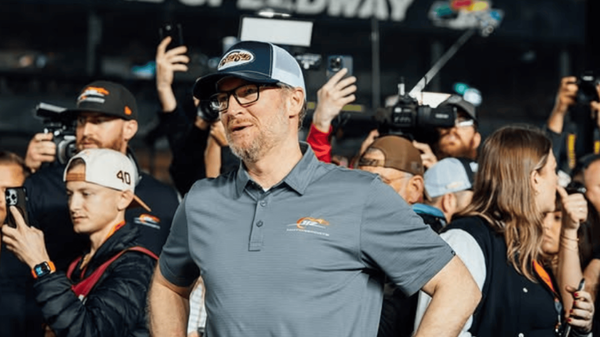

In the shadow of North Carolina’s pine trees, a racetrack known for eating tires and crushing spirits is making its long-awaited comeback to NASCAR. For Dale Earnhardt Jr., Rockingham Speedway—affectionately known as “The Rock”—stands as both battlefield and teacher, a place where he endured years of frustration before finally cracking its code in what would become their final encounter.
As NASCAR prepares for its triumphant return to Rockingham after a $9 million renovation, Dale Jr.’s candid reflections offer a window into why this track holds such a mythical status in racing lore. For a driver whose surname is synonymous with NASCAR excellence, his struggles at “The Rock” reveal the unforgiving nature of a venue that demanded perfection and punished the slightest miscalculation—qualities that both frustrated and eventually fascinated one of the sport’s most beloved figures.
ADVERTISEMENT
Article continues below this ad
Dale Jr.’s rocky relationship with “The Rock”
Earnhardt’s challenging history at Rockingham began in 1997 during his Xfinity Series debut at the track. “My track bar was dropping on the right side as we ran the race. I ended up running 14th or something and struggled, but not too bad,” he recalled. That first encounter would set the tone for years to come. Through five Xfinity Series starts at the track, Junior never managed to break into the top 10—a striking statistic for a driver with two Xfinity Championships who would later be inducted into NASCAR’s Hall of Fame.
The frustration continued into his Cup Series career, where for eight of his nine races at Rockingham, top-10 finishes remained elusive. “It just made me have a hard time appreciating the track because of how brutal it could be,” Earnhardt explained. His worst moment came in 2001, when he raced at Rockingham the week after his father, Dale Earnhardt Sr., tragically died at the Daytona 500 following a last-lap crash. “In ’01 wrecked there. Embarrassed the hell out of me. Dad was killed at Daytona, then I go there [Rockingham] and wrecked in a very similar-looking accident. I was so embarrassed.”
Earnhardt Jr. does not share the same positive view of “The Rock” race track as fans now that NASCAR has selected it to resume competition next year. “I hated that place until the very last race. Now I’m almost sad that I didn’t get more shots at running there.” Earnhardt recently confessed on the Dale Jr. Download.

What’s your perspective on:
Is Rockingham's return to NASCAR a nod to nostalgia, or a step backward for the sport?
Have an interesting take?
Junior finally decoded the secrets of “The Rock” during what would become his final appearance there in 2004, finishing fifth. “I had a good car, and I felt like I’d figured it out. I was like, ‘Man, that was pretty fun.’ Then we quit going,” he lamented, highlighting the bittersweet timing of NASCAR’s decision to remove the track from its schedule just as he had begun to master it. However, the revamp was necessary, and the racer continues to value tracks made from damaged asphalt instead of fresh pavement.
The $9 million modernization project turned an abandoned site into a contemporary racing arena, which now welcomes the premier NASCAR racing events. Junior states that “The Rock” still maintains its competitive nature despite the upgrade work. “Rockingham is fast as lightning!” Earnhardt used this phrase to describe the notorious speed of Rockingham after watching young driver Rajah Caruth’s onboard footage from the freshly rebuilt facility.
Rockingham will become the target track for Xfinity and Truck Series drivers in 2025, and Earnhardt’s account functions as a combination of constructive knowledge and advice. The drivers preparing for “The Rock” event will face a challenging oval course that tested NASCAR royalty Dale Jr., even after he achieved peace with his challenges.
Trending
From race tracks to rock venues: Dale Jr.’s expanding brand empire
While Dale Earnhardt Jr. works through his complicated feelings about NASCAR’s return to Rockingham, he’s simultaneously expanding his business portfolio with strategic partnerships that extend his influence beyond the racetrack. His recently announced collaboration with Hard Rock Cafe represents a significant milestone in his post-driving career, bringing together two iconic American brands. The partnership, which includes exclusive merchandise featuring his famous No. 8, allows Junior to connect with fans in environments far removed from the smell of burning rubber and racing fuel that defined his competitive years.
ADVERTISEMENT
Article continues below this ad
The timing of this Hard Rock deal is particularly noteworthy as it coincides with NASCAR’s revival of legacy tracks like Rockingham, suggesting a pattern of nostalgia-driven marketing that resonates with both brands. “It’s a brand that is a fun brand. It’s something that I personally enjoy and I was excited to put this partnership together,” Earnhardt told Racing America on SI, highlighting the natural alignment between his personal interests and the Hard Rock culture. The deal also incorporates Junior’s High Rock Vodka brand, creating opportunities for custom menu items and specialty drinks that will be available at Hard Rock locations nationwide.
Earnhardt’s expanding business empire ensures that his influence on the sport extends far beyond his driving statistics, creating new touchpoints for fans to connect with the Earnhardt legacy through merchandise, spirits, and now, Buffalo chicken wings at Hard Rock Cafe.
ADVERTISEMENT
Article continues below this ad
ADVERTISEMENT
ADVERTISEMENT
ADVERTISEMENT
ADVERTISEMENT


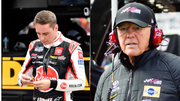
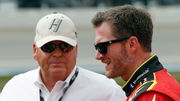
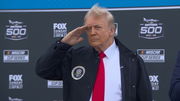
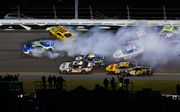

Is Rockingham's return to NASCAR a nod to nostalgia, or a step backward for the sport?